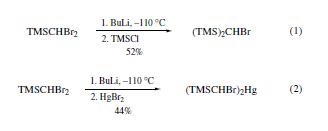|
|
| | (Dibromomethyl)trimethylsilane Basic information |
| | (Dibromomethyl)trimethylsilane Chemical Properties |
| Boiling point | 82.5 °C(Press: 50 Torr) | | density | 1.566±0.06 g/cm3(Predicted) | | solubility | sol most organic solvents. |
| | (Dibromomethyl)trimethylsilane Usage And Synthesis |
| Physical properties | bp 49.5–51.5°C/12 mmHg; d 1.519 g cm?3. | | Uses | Reaction of (dibromomethyl)-
trimethylsilane with n-butyllithium at ?110°C results in the
formation of trimethylsilylbromomethyllithium. The silane and
the n-BuLi are added simultaneously in order to suppress side
reactions. Treatment of the intermediate lithium reagent with
chlorotrimethylsilane (eq 1) or mercury(II) bromide (eq 2)
affords bis(trimethylsilyl)bromomethane or bis(trimethylsilylbromomethyl)
mercury, respectively. If the lithium reagent is allowed to warm in the presence of cyclohexene, the only reaction
observed is an alkylation with the n-butyl bromide formed
in the exchange reaction. The alkylated product is formed in 89%
yield. | | Preparation | to a dry, 1.0 L three-neck flask, equipped
with a mechanical stirrer, a pentane thermometer, a nitrogen inlet
tube, and a pressure-equalizing addition funnel, was added
62.0 g (0.245 mol) of bromoform and 300 mL of dry THF.
The reaction was cooled to ?90°C and 0.25 mol of isopropylmagnesium
chloride in 200 mL of THF was added during 30
min at such a rate that the temperature was kept at ?80°C
or below. The reaction was stirred at ?90°C for 15 min and
then 0.25 mol of chlorotrimethylsilane in 100 mL of THF was
added at such a rate that the temperature did not exceed?80°C.
After 1 h, the reaction was allowed to warm to rt. The reaction
mixture was hydrolyzed with saturated NH4Cl solution
until large lumps of salt cake formed. The organic layer was
poured off, dried over anhydrous Na2SO4, and distilled at atmospheric
pressure to remove most of the THF. A trap-to-trap
distillation of the residue at 0.1 mmHg was followed by distillation
through an 11 in. Vigreux column. The fraction boiling at
49.5–51.5°C/12 mmHg was collected, affording 47.9 g (79%)
of (dibromomethyl)trimethylsilane. |
| | (Dibromomethyl)trimethylsilane Preparation Products And Raw materials |
|